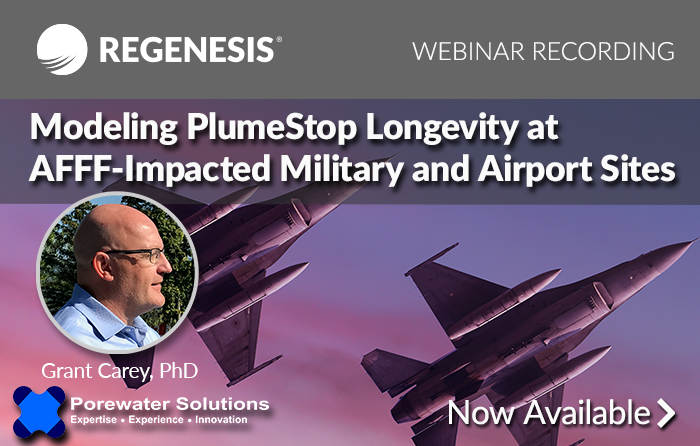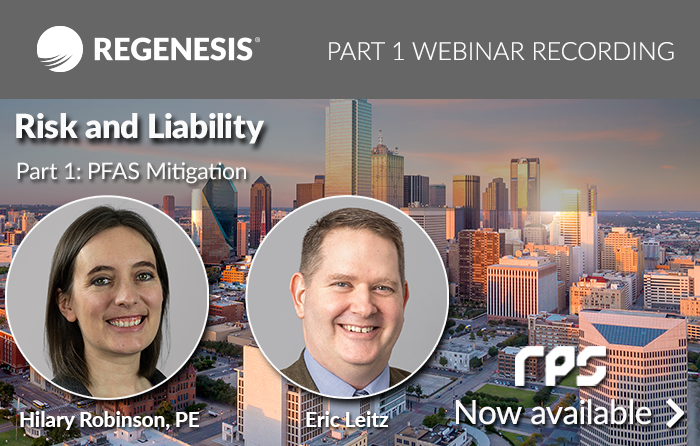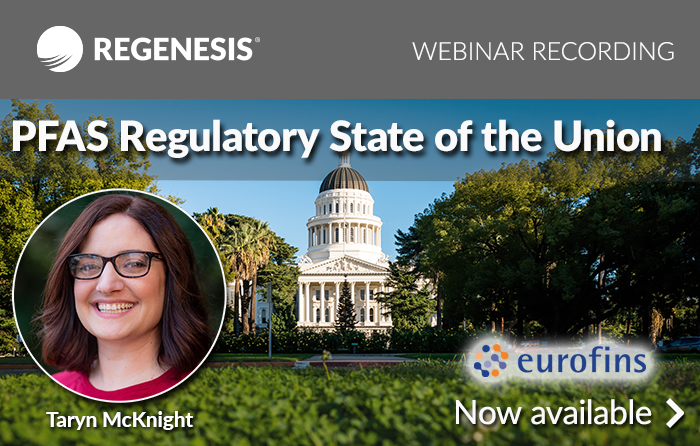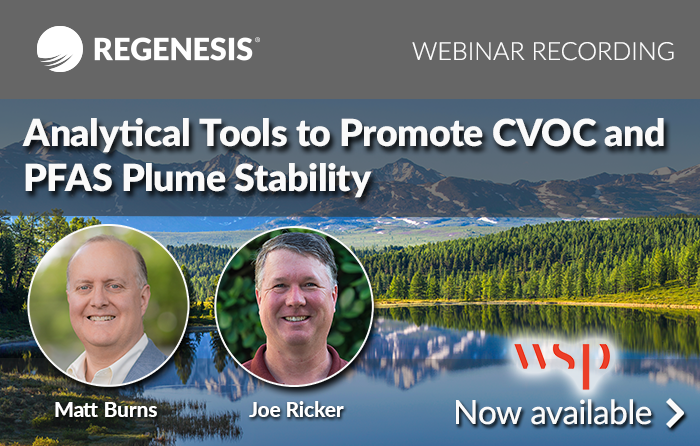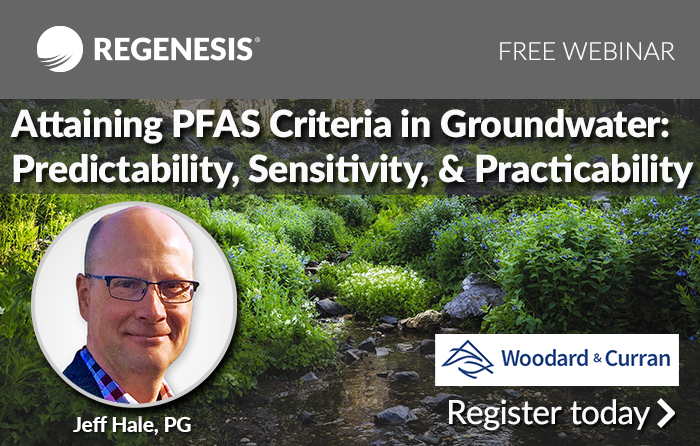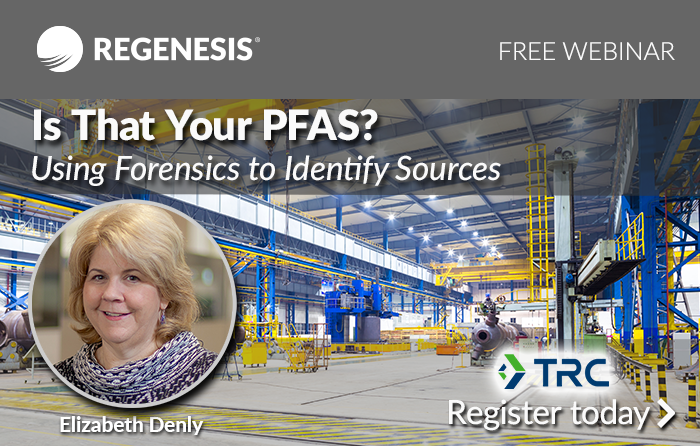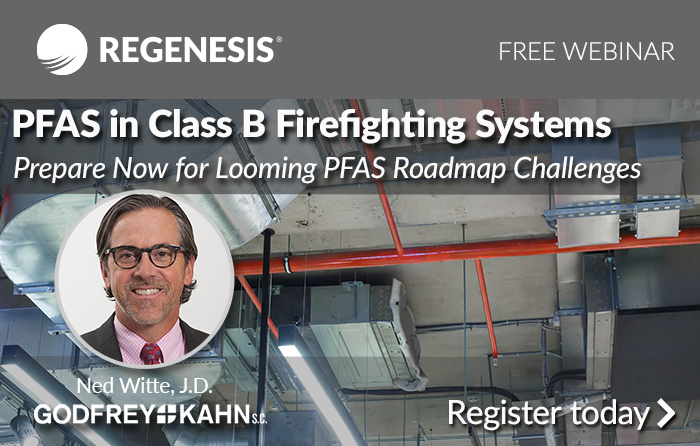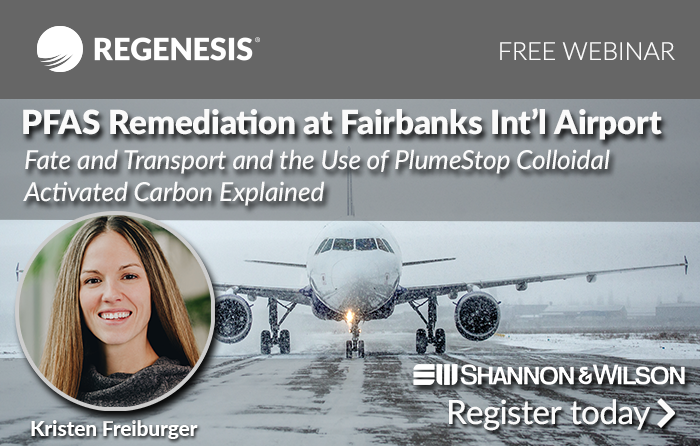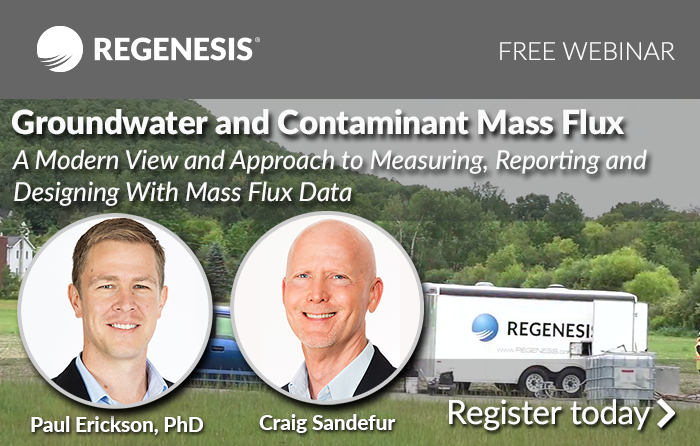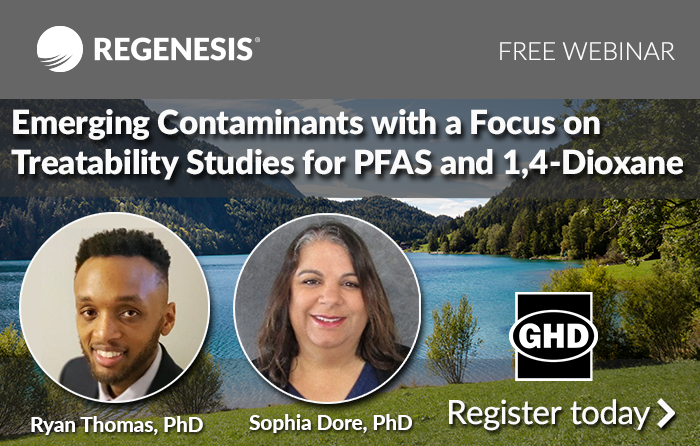Modeling PlumeStop Longevity at AFFF-Impacted Military and Airport Sites
In this webinar we were pleased to have as a special guest speaker, globally-recognized PFAS modeling expert and recent lead author of the REMEDIATION Journal article titled Longevity of colloidal activated carbon for in situ PFAS remediation at AFFF-contaminated airport sites, Grant Carey, PhD, President of Porewater Solutions. His presentation discussed modeling PlumeStop® longevity at AFFF-impacted military and airport sites. He was joined by Scott Wilson, President & CEO of REGENESIS, who provided an update on the use of colloidal activated carbon as a sustainable, low-cost method to eliminate PFAS risk and liability.
Highlights of this free webinar:
- Case studies of 17 PFAS field sites showing successful PlumeStop performance results for up to six years and counting
- In-Situ Remediation Model (ISR-MT3DMS) indicates PlumeStop longevity that may occur at a wide range of AFFF-impacted military and airport sites
- Remedial alternatives that may be used in combination with PlumeStop at AFFF-impacted sites will be discussed
There is growing interest in the use of PlumeStop to sequester PFAS in groundwater sorption zones. PlumeStop contains colloidal activated carbon (CAC) particles which are sufficiently small to allow for easy injection into porous media. The performance of PlumeStop at 17 PFAS field sites is summarized, including upgradient concentrations of PFAS, organic co-contaminants, and native organic matter; and the fraction of CAC in soil after injection. These case studies demonstrate that PlumeStop has been used successfully at PFAS field sites with total monitoring periods to-date ranging from 0.3 to six years.
A review of state and federal guidance indicates that the four most frequent PFAS of interest are PFOS, PFOA, PFHxS, and PFNA. A sensitivity analysis using the In-Situ Remediation Model (ISR-MT3DMS) illustrates the magnitude of PlumeStop longevity that may occur at a wide range of AFFF-impacted military and airport sites. A statistical analysis of PFAS concentrations at 96 AFFF-impacted sites and laboratory batch tests supported this modeling study. Various influencing factors were modeled, including plume concentrations, groundwater velocity, the engineered fraction of CAC in soil, and sorption isotherm properties. Remedial alternatives that may be used in combination with PlumeStop at AFFF-impacted sites are discussed.
Complete the form on this page to view this free webinar.
Webinar recording available
Risk and Liability – Part 1: PFAS Mitigation and Managing Liabilities
This webinar is Part 1 in a two-part webinar series featuring special guest speakers Hilary Robinson, PE, Emerging Contaminants Lead and Eric Leitz, Director of Legacy Site Services at RPS Group. Their presentation discussed risk and managing liabilities, taking a look at PFAS contamination.
Part 1: Risk and Liability – PFAS Mitigation and Managing Liabilities
- Selecting practical sampling and analytical methods to assess past and present risks
- Developing achievable and effective response strategies in light of stringent EPA advisories and developing regulations
- How the industrial history and unique chemistry of PFAS affects its presence, behavior, and risks posed at a site
If PFAS are “everywhere,” how can that risk be managed to maintain financial assurance or facilitate a transaction? We will describe our varied experience scaling an investigative response to the problem at hand, from performing diligence on processes and waste streams to sampling, sampling, and more sampling. State and Federal agencies have generally provided only limited guidance, and courts have similarly only weighed in on a limited number of specific cases. Therefore, pragmatic approaches can help to analyze the evolving regulatory and legal environment to understand and manage the potential consequences PFAS may have on transactions, facility operations, and personnel or the public.
Recording now available
PFAS Regulatory State of the Union
In this webinar we were pleased to have special guest speaker Taryn McKnight, PFAS Practice Leader for Eurofins Environment Testing America. Her presentation discussed regulatory actions at both the federal and state level to address PFAS contamination. She was joined by Paul Erickson, PhD, Director of Research & Development at REGENESIS.
Highlights of this free webinar:
- A catalogue of notable and lesser known relevant regulatory actions at both the federal and state level targeting PFAS
- A state of the science with regards to a range of PFAS research topics and scientific developments
- Latest news on toxicology, health studies, analytical method development, and understanding the fate and transport of PFAS
Complete the form on this page to view this free webinar.
Recording now available
Analytical Tools to Promote CVOC and PFAS Plume Stability
In this webinar we are pleased to have special guest speakers WSP’s Matt Burns, VP and Technical Director of the Earth and Environment Practice, and Joe Ricker, Senior Technical Principal. Their presentation will discuss the use of plume analytics, focusing on its potential applicability to MNA of PFAS, and its usefulness in assessing CVOC plume stability. They will be joined by Maureen Dooley, Vice President – Industrial Sector at REGENESIS.
Highlights of this free webinar:
- Potential applicability of plume analytics to MNA of PFAS
- Using analytics to assess plume stability and other plume attributes, with examples from remediation sites
- Use of colloidal activate carbon to eliminate risk of PFAS contamination in groundwater
Complete the form on this page to sign up for this free webinar.
Recording now available
Attaining PFAS Criteria in Groundwater: Predictability, Sensitivity, & Practicability
In this webinar we were pleased to have as a special guest speaker Jeff Hale, Practice Leader – Emerging Contaminants at Woodard and Curran. His presentation discussed attaining PFAS criteria in groundwater. He was joined by Dr. Kristen Thoreson, Vice President of Quality and Process Improvement at REGENESIS, who discussed the latest developments about colloidal activated carbon’s use in the remediation industry as a low-cost method of eliminating PFAS risk.
Highlights of this free webinar:
- Examination of the practicability of attaining PFAS criteria in groundwater and the distance from source at which these regulatory criteria are attained
- Empirical fate & transport modeling using available data sources demonstrates expected distances to attainment of regulatory criteria
- Use of colloidal activate carbon to eliminate risk of PFAS contamination in groundwater
Regulatory jurisdictions are establishing increasingly stringent, health-based criteria for per and polyfluoroalkyl substances (PFAS) in groundwater with the aim of protecting receptors at the point of exposure. The practicability of attaining these criteria in groundwater and the distance from source at which these regulatory criteria are attained without intervention have received little evaluation. Empirical fate & transport modeling using available data sources demonstrates expected distances to attainment, as well as the sensitivity of that attainment distance to various regulatory criteria and guidance values. The statistical distribution of these PFAS data sets also informs the approach and practicability of potential groundwater remedies.
View webinar
Is That Your PFAS? Using Forensics to Identify Sources
Date: Tuesday, May 17th, 2022
Time: 11am pacific / 2pm eastern
In this webinar we are pleased to have as a special guest speaker Elizabeth Denly, PFAS Initiative Leader & Chemistry Director at TRC. Her presentation will discuss using forensics to identify sources of PFAS.
Highlights of this free webinar:
- The efficacy and limitations of using PFAS analytes as fingerprints for source identification
- Demonstrating the challenges of source identification due to chemical signatures from samples collected at numerous PFAS source areas
- Use of chemical signatures in combination with fate and transport mechanisms for PFAS source identification
Evaluation of the relative composition of individual PFAS compounds in surface water and groundwater samples can be an effective method to identify the source(s) of PFAS in these media. The list of PFAS compounds that laboratories are able to detect, and the list of analytes required by various regulatory agencies continues to expand. As a result, the number of compounds that can be used to “fingerprint” samples is variable with time and with location. Comparison of chemical fingerprints in samples collected from surface water bodies and groundwater located downstream and downgradient of contaminated sites may appear to be the same simply because of the suite of analytes chosen for fingerprinting. Chemical signatures in combination with fate and transport mechanisms (e.g., commingling, persistence, sorption, dilution) must be considered during source identification. Using literature-based data and data collected by the authors, chemical signatures from samples collected at numerous PFAS source areas demonstrate how identification of sources can be challenging. Attendees will learn about the efficacy and limitations of using PFAS analytes as fingerprints for source identification and delineation.
Sign up today
PFAS in Class B Firefighting Systems – Prepare Now for Looming PFAS Roadmap Challenges
In this webinar we were pleased to have a special presentation from Ned Witte, Attorney at Godfrey & Kahn, S.C. His presentation discussed PFAS in Class B firefighting systems, and how to prepare for looming PFAS Roadmap challenges.
Highlights of this free webinar:
- Proactive best practices owners of Class B systems should employ now
- Regulatory developments that will have dramatic effects on owners and operators of PFAS-containing AFFF Class B firefighting systems
- Discussion of Class B systems and the relationship of National Fire Prevention insurance standards
- The propensity of PFAS releases from Class B systems
- The application of coming federal PFAS regulations
Momentum is gaining for comprehensive federal regulation of PFAS, as identified in the October 2021 U.S.EPA PFAS Strategic Roadmap, including identification of certain PFAS as CERCLA “hazardous substances” and development of enforceable maximum contaminant levels, or MCLs, for PFAS. While these regulatory developments will impact all businesses and properties that PFAS has touched, the federal rules – and existing and developing state laws – will have dramatic effects on owners and operators of PFAS-containing AFFF Class B Firefighting Systems.
Recording now available
PFAS Remediation at Fairbanks International Airport: Fate and Transport of PFAS and the Use of Colloidal Activated Carbon
In this webinar we were pleased to have as a special guest speaker Kristen Freiburger, Associate at Shannon & Wilson. Her presentation discussed PFAS remediation at Fairbanks International Airport, including a discussion of fate and transport of PFAS and the use of PlumeStop colloidal activated carbon.
Highlights of this free webinar:
-
- The presumed source of PFAS in groundwater in many Alaskan communities is the use of AFFF by airport rescue and firefighting at Part 139 Airports operated by Alaska DOT&PF
- Fate and transport of PFAS as it relates to projects at Gustavus and Fairbanks Airports
- Use of PlumeStop to address PFAS contamination at the Fairbanks International Airport
PFAS are highly soluble in water and have a very strong carbon-fluorine backbone making them resistant to traditional remediation technologies and natural attenuation. PFAS that enter groundwater are known to be persistent and travel long distances. Fate and transport of PFAS in groundwater depends on the environment which they were released and the physical properties of the PFAS being examined (e.g., carbon chain lengths, linear/branched isomers, functional groups, and degree of fluorination). The presumed source of PFAS in groundwater in many Alaskan communities is the use of AFFF by airport rescue and firefighting at Part 139 Airports operated by Alaska DOT&PF. When AFFF releases occur in areas served by private or public drinking water wells, the well water is susceptible to contamination. Kristen Freiburger will discuss the fate and transport of PFAS as it relates to her PFAS work of the Gustavus and Fairbanks Airports including the use of PlumeStop at the Fairbanks International Airport. This discussion will focus on the challenges of understanding fate and transport of PFAS.
Recording now available
Groundwater and Contaminant Mass Flux: A Modern View and Approach to Measuring, Reporting and Designing With Mass Flux Data
In this webinar we were pleased to have a special presentation from Paul Erickson, PhD, Director of Research & Development at REGENESIS, and Craig Sandefur, Vice President of Remedial Applications Development at REGENESIS. Their presentation discussed groundwater and contaminant mass flux and a modern approach to measuring, reporting and designing with mass flux data.
This free webinar will:
-
- Flux Tracer™ a flux measurement tool developed by REGENESIS that is easier to deploy and retrieve than alternative methods of collecting groundwater and contaminant mass flux data
- Why the data collected by direct mass flux measurements is far superior to traditional means of estimation (groundwater extraction or slug tests)
- Examples of REGENESIS Flux Tracer reports and discuss how mass flux data and are integrated into our treatment design process
Permeable Reactive Barriers are standard approach for the remediation of large elongate plumes however, PRB’s are particularly sensitive to mass flux. This makes technologies that can directly measure mass flux very valuable. Historically Remediation Practitioners have relied on Water Resource methods (GW Extraction Tests and/or Slug Tests) to measure design critical PRB aquifer characteristics. Unfortunately, these measurement methods generally provide results in terms of aquifer bulk averages and do identify or measure those contaminant mass flux zones that control contaminant migration. Results of Mass Flux provide a direct measurement and quantification of contaminant concentration measure in milligrams per liter passing through the surface area of an imaginary plane of compliance measured in meters2 for a set period of time measured in days. These three variables are exactly what is necessary to design an effective and successful PRB.
REGENESIS has developed a flux measurement tool that has a better form factor (Flux Tracer). This device has significant improvements in the areas of ease of use and reductions in time for field installation and retrieval. This Webinar will discuss the above topics as well as provide examples of REGENESIS Flux Tracer Reports and a brief discussion of the Data (Interpretation/Observations). In addition how REGENESIS designers use Flux Tracer and other mass flux data as direct PRB design inputs.
Recording now available
Emerging Contaminants with a Focus on Treatability Studies for PFAS and 1,4-Dioxane
In this webinar we were pleased to have as special guests speaker Ryan Thomas, PhD, Associate and Emerging Contaminants Practice Leader and Sophia Dore, PhD, Associate and Director of the Innovative Technology Group at GHD. Their presentation discussed emerging contaminants with a focus on treatability studies for PFAS and 1,4-Dioxane.
This free webinar will:
-
- Provide a general overview of emerging contaminants
- Identify the regulations in the various states
- Overview available analytical methods and treatment technologies
- Offer proactive considerations related to addressing PFAS and 1,4-Dioxane concerns
- Provide an overview of the application of laboratory studies to study treatment of PFAS and 1,4-Dioxane
- Provide case studies where treatability studies were used to understand and model treatment of PFAS and 1,4-Dioxane
Emerging Contaminants consist of synthetic or naturally occurring chemicals or microorganisms that are not routinely monitored in the environment but have the potential to impact sensitive receptors such as drinking water sources and other water sources and potentially cause negative human health and/or ecological effects. These contaminants are increasingly being detected in water, soil, landfill leachate, and other media. As a result of emerging contaminants being detected in the environment, evaluations to determine the need for regulation are routinely performed that may impact many water and environmental professionals. Of the numerous potential emerging contaminants, per- and polyfluoroalkyl substances (PFAS) and 1,4-dioxane are consistently being evaluated for stringent regulation at the Federal and State levels.Treatability studies model processes occurring in the environment or in treatment plants at a small scale. They are particularly well suited to emerging contaminants because procedures and doses for treatment are not well established and the ability to test multiple doses/retention times or other treatment parameters within a short period of time to determine the optimum treatment is an advantage.

 Americas
Americas Europe
Europe Français
Français Deutsch
Deutsch Italiano
Italiano Español
Español